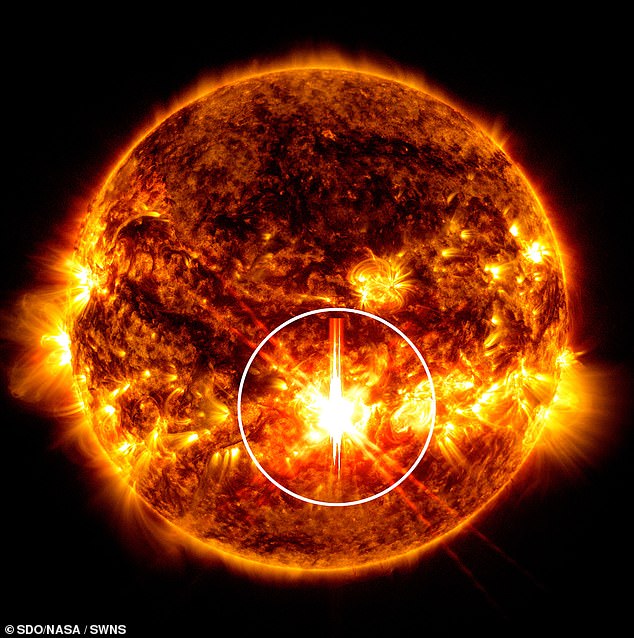A historic solar flare heading toward Earth will produce stunning auroras in the northern US. Here you can see the phenomenon
The sun unleashed a historic solar flare on Thursday, which is expected to produce glorious auroras across the northern US when it hits our planet.
The massive radiation explosion, the largest in seven years, could also cause radio interference and disrupt satellites and GPS systems.
But the National Oceanic and Atmospheric Association (NOAA) has predicted the most likely scenario of bright, colorful lights streaking across the night sky as far south as New York, Nebraska and Indiana.
The eruption will hit Earth on Friday, with NOAA saying the best views of auroras will be Saturday.
Stunning auroras will be visible in several US states from Friday to Sunday, with experts predicting the best views will be seen on Saturday
Silvia Dalla, professor of solar physics at the University of Central Lancashire, said: ‘Look north and try to find a spot with dark skies, ideally away from a city where light pollution can disrupt the view.’
NOAA has advised those hoping to see the Northern Lights to get away from the city lights.
The best viewing time is usually within an hour or two before or after midnight, and the agency says the best opportunities are around the spring and autumn equinoxes, because of the way the solar wind interacts with Earth’s magnetosphere.
Meteorologists have predicted that Alaska and Canada will have aurora overhead, along with the northernmost regions of Washington, Idaho, Montana, North Dakota, Minnesota, Maine and Michigan.
The southern parts of these states and New York, New Hampshire, Connecticut, Rhode Island, Colorado, Oregon, Nevada, Iowa and Nebraska will see a northern glow in the night sky.
And Ohio, Indiana, New Jersey, Nevada and Utah Missouri can capture the images using cameras.
NASA’s Solar Dynamics Observatory, which continuously watches the sun, captured the massive eruption on Thursday.
Flares and solar eruptions can affect radio communications, power grids and navigation signals and pose risks to spacecraft and astronauts.
“Solar flares and fast coronal mass ejections (CMEs) are large outbursts of plasma and magnetic fields,” says Dalla.
‘This strong geomagnetic activity results in breathtaking displays of the Northern Lights.
The powerful solar flare, an X9.05, peaked at 8:10 a.m. ET, causing power outages over parts of Africa and Europe.

The aurorae are due to the sun releasing a huge blast of radiation on Thursday, which was captured by the NASA observatory orbiting Earth’s star.
X is the largest class of solar flares, which can cause radio disruptions and widespread damage to satellites, spacecraft and power grids around the world.
It is followed by the M, C and B classes in decreasing order of severity. Within each letter class there is a finer scale from one to nine that further specifies the intensity of the flare.
The X9.05 flare exploded from sunspot AR3842, a dark, fast-growing region of strong magnetic fields on the Sun’s surface, where another had been released earlier on Tuesday.
The eruptions have put Earth under a geomagnetic alert, which is a major disruption of Earth’s magnetosphere – the region around Earth governed by the planet’s magnetic field.
NOAA has issued a G3 warning from today through Sunday, which could disrupt power systems, spacecraft operations, GPS and radio navigation.
Dr. Steph Yardley, a space scientist at Northumbria University, said the area of the Sun that produces solar flares has been particularly active.
“This area of the Sun is one to watch as it has been quite active in recent days, producing another strong outburst earlier on October 1 that was also related to a solar outburst,” she explained.
‘Both eruptions associated with the strong outbursts are aimed at Earth and we expect them to hit us sometime between October 4 and 6, meaning auroras could be visible in Scotland and northern England during this period.’
